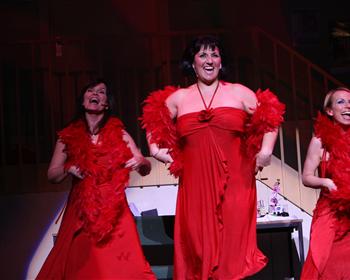“What do you go for,
Go see a show for?
Tell the truth
You go to see those beautiful dames!”
I am deeply in love with traditional theatres and The New Wimbledon Theatre is one of these. With it’s old world charm; authentic decoration and attention to detail creates an atmosphere to take you back in time. Deep red velvet curtains seem enchanting even under the glow of house lights. An old fashioned Orchestra pit bridges the gap between audience and actor. The intro begins and the steady hum of an anticipating audience only heightens the buzz. Suddenly, lights dim, spectators hush and the curtain is raised – pausing to emphasise the company’s talented, tap dancing feet, before continuing upwards and revealing, to the delight of the audience, a terrific opening number, “Audition”.
A conventional musical in many ways 42nd Street has a basic but satisfying and enjoyable plot. This simple story serves its main purpose effectively; it is an opportunity for the audience to escape in somebody else’s successful dream. It also makes use of a convention frequently used in musicals which excuses what would otherwise be out of place song and dance numbers, the story is around a show within a show.
42nd Street was originally a hit film in the 1930’s, its success due in part to its social context. Written and set during the time of the Depression, it tells the tale of young chorus girl Peggy Sawyer (played by Jessica Punch), who miraculously takes over from the show’s “talentless” star Dorothy Brock, (played by Julia J Nagle); a dragon of a woman who is much disliked.
Musicals always require the audience to suspend their disbelief just a little bit more than any other genre. When a fully participating audience does this, shows like 42nd Street allows them to experience and appreciate the surreal glitz and glamour of show business in all its sequined and tap dancing glory.
There are many great songs to remember, the show’s title number 42nd Street, Dames and We’re in the money to name but a few; but as the song Dames correctly prophesises, the women in this production really steal the show.
The chorus is particularly talented Anytime Annie (played by Rebecca Marks) leads them well in showcasing genuinely impressive tap dancing. Great timing, style and skill; I could not find fault with these girls. Their energy and enthusiasm was contagious. My only disappointment was during the Busby Berkeley inspired dance sequence, when a mirror reflects the aerial perspective of their dance to the audience. Unfortunately the mirror used was made up of many smaller ones and meant the view was somewhat disjointed. Sadly, appreciating what was no doubt a very polished dance routine was somewhat hindered.
Jessica Punche’s performance as Peggy Sawyer deserves much commendation. She connected with the audience with terrific (and often comical) facial expressions, her naivety was convincing and delightful but her ability to sing and dance held the whole show together. Despite a brief technical hitch with her microphone she was consistently the best performer on the stage.
While the cast as a whole did not excel in singing, one voice did noticeably stand out above the rest; Maggie Jones (played by Shirley Jameson) had gusto and talent that made her a pleasure to listen to but in fairness, 42nd Street is suited to showing off strong dancers and that’s exactly what it did.
If you are looking for an enjoyable night filled with some of the best tap dancing around, 42nd Street at the New Wimbledon theatre will truly satisfy; I had stars in my eyes and toes that yearned to tap all the way home.


